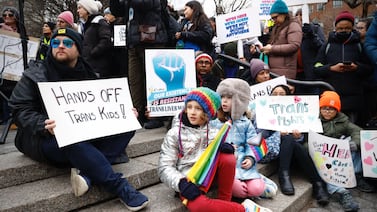Data from the first graduating class of students to have gone an entire year through the pandemic shows variation and big disparities, but not huge drops in Colorado’s graduation rate.
Statewide, 81.7% of the Class of 2021 graduated on time last spring — slightly down from 81.9% in 2020, according to data published by the Colorado Department of Education Tuesday. Although the dip may be statistically insignificant, it represents the first time in a decade that Colorado’s annual graduation rate didn’t increase.
“We know how tough it was for everyone last school year due to the challenges brought on by the pandemic with schools going to remote learning and others offering hybrid models,” said Katy Anthes, Colorado’s education commissioner, in a released statement. “It is a relief that the graduation rate is nearly the same as it was the previous year. With the state’s dropout rate also nearly unchanged, it is a concrete display of the dedication and determination of Colorado’s students, parents and teachers, especially during these tough times.”
However, racial disparities increased in the past year with students of color seeing drops in their graduation rates where white students didn’t. Students identified as Indigenous or Hispanic posted the largest drops among racial groups in graduation rates this year. Black students also showed a drop.
Districts with large portions of students from low-income families also posted drops in their rate compared with last year. In the metro area, Sheridan, Englewood, and Westminster school districts had some of the largest drops, despite all having posted increases in 2020.
The Denver school district, the largest in the state, posted a 74% graduation rate, just slightly down from 74.6% in 2020.
In northern Colorado, the Greeley school district managed to continue its upward trend. This year, the district had a graduation rate of 84.1%, up from 82% in 2020, and 81.7% in 2019.
Deirdre Pilch, the Greeley superintendent, said that increasing graduation rates has been one of her main priorities since she became superintendent in 2015. It’s part of a strategic plan that pre-pandemic included close monitoring of students from their first year of high school. Students who are at high risk of not graduating on time are actually identified in middle school so they can receive additional support.
During the pandemic, the Greeley district that serves nearly 22,000 students — including 70% students of color, and about 66% students who qualify for subsidized lunches, a measure of poverty — met mostly in person, though high school students had hybrid schedules with just two days per week of in-person learning during more than half of the year.
To keep quarantines to a minimum, the district also switched to a quarter system where high school students only took four classes at a time. And groups of students who had special needs, or those who were learning English as a second language, had more in-person instruction throughout the year.
The spring 2021 semester ended with all students in person five days a week.
“It absolutely had to make a difference,” Pilch said. “Teachers and staff were saying, ‘we need our kids every day, we got to have them every day.’ There’s no question you’re seeing that in this data.”
Despite the win, the Greeley district also had a slight increase in the number of students who dropped out.
“It’s absolutely the pandemic,” Pilch said. “We’ve gone down mostly every year, we shouldn’t have a slight uptick. Families who were the most impacted suffered the most. There are kids we lost and we don’t know where they went.”
Over the summer, the district used some of its ESSER federal relief dollars to hire two additional attendance advocates to find missing students. Pilch said the two found and re-enrolled nearly 200 K-12 students who had been missing. Now they work to keep those students engaged.
The small district of Sheridan, which borders southwest Denver, experienced a big drop in its graduation rate. But because the district is so small, the drop represents just a handful of students.
Maegan Daigler, the district’s executive director of assessment and technology, said that Sheridan officials found students at the alternative high school who said they wanted to continue school, but not while the district was in remote learning. Those students may have counted as dropouts, even though they have re-enrolled this school year, Daigler said.
Sheridan now also has a district position dedicated to helping students re-engage and re-enroll in school. The rate of students coming back to school has increased, she said.
Daigler also pointed out that Sheridan has been increasing graduation rates for students who take longer than four years. The six-year graduation rate for Sheridan High School was 100%, she said.
Data manager Duncan Anderson, said Sheridan is in a position to be able to offer individualized planning for each student. The graduation data might help the district continue to do that.
“Acknowledging the pandemic was a real struggle for some students and as a result might need an additional year of high school,” Anderson said.
Statewide, the rate of students completing high school in five, six, or seven years, has continued to increase. A total of 9.7% of the Class of 2021, or about 6,614 students, remain enrolled and could still finish high school in their fifth, sixth, or seventh year.
Look up your school or district’s four-year rate below:







